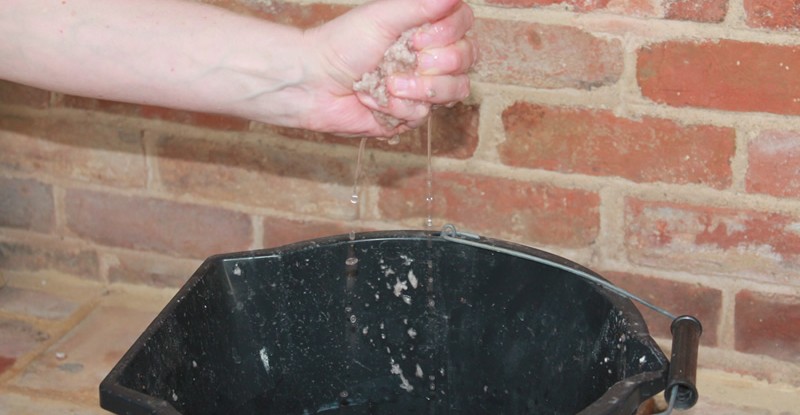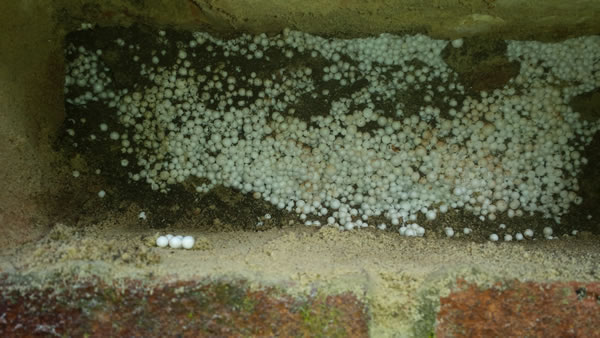The government is keen for home-owners to insulate their homes, but cavity walls were built as a barrier against penetrating dampness, So what happens when you fill an empty cavity with insulating material? Or in other words, when is a cavity wall not a cavity wall? Answer: when it is filled with damp fluffy stuff.
There is a photo showing damp mineral-wool fibre being removed from a house on page 157 of my book, “The Sunday Telegraph Guide to Looking After Your Property”, available via the books page of this website.
Confusion over filled cavities
The government has announced plans to accelerate the installation of cavity wall insulation, as part of its response to rising energy costs. Specifically, cavity wall insulation is now to be offered free to all homeowners over the age of 70.
This has resulted in a large increase in the number of letters and e-mails I have received about the subject. I am sceptical about the advisability of injecting insulation into existing cavity walls – a position I take because of my own background experience, as a trained and experienced bricklayer, university construction lecturer, and lately as building columnist for The Sunday Telegraph.
Most of the letters ask a simple question. Heating costs are at an all-time high, they say, which is a huge burden on people on fixed incomes, particular pensioners. So should they take up the offer of free cavity wall insulation?
I cannot make this decision for anyone. All I can do is provide the information for readers to make informed decisions for themselves. So these are the facts.
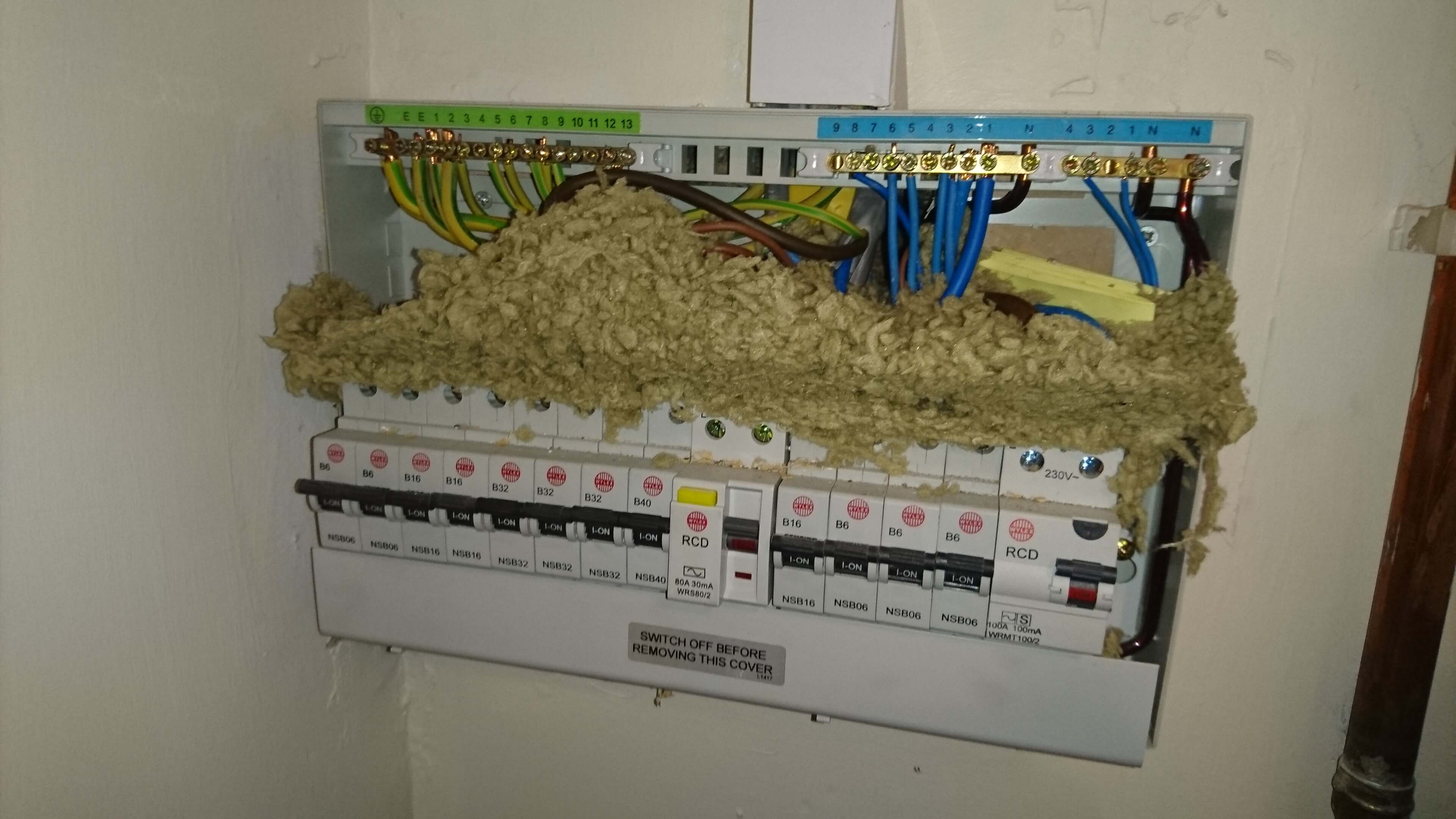
“Cavity insulation often gets into electrical consumer units, causing trip-outs and a fire risk”. (Photo: Mick Spencer & Professional Electrician magazine).
Cavity Wall Insulation Facts
Cavity masonry walls were introduced on the exposed western coasts of Britain and Ireland in the nineteenth century, to stop wind-driven rain from penetrating to the inside surfaces. They gradually spread to other, dryer, parts of the country, because the air layer trapped in the cavity was found to provide a degree of thermal insulation. Since 1945 this insulation quality has been enhanced by using lightweight blocks, rather than bricks, to build the inner leaf of the wall. But the main reason for building cavity walls has always been to keep the rain out.
Since the 1980s, the Building Regulations have required new houses to be built with insulation material in the cavity. As long as they are built properly, this insulation should not compromise the walls’ resistance to rain penetration.
In most cases, the insulation is fixed to the inner leaf, leaving a narrow cavity to intercept any rainwater that penetrates the outer brick leaf. This insulation material is usually in the form of rigid foam boards, which are intrinsically waterproof, or semi-rigid mineral-wool or glassfibre “batts”, where the fibres are aligned vertically so that any penetrating rainwater should drain downwards in the cavity and not have the chance to penetrate across to the inner leaf. This is important, because the Building Research Establishment has found that single-leaf brick walls ALWAYS leak when exposed to wind-driven rain. The leakage occurs at the vertical (or “perp”) joints between adjacent bricks, because of drying shrinkage in the mortar. It is not a question of poor workmanship; it is an inevitable property of this form of construction.
Many readers with single-leaf brick garages attached to their cavity-walled homes, for example, complain that rainwater penetrates through from the outside when they are subjected to wind-driven rain, resulting in puddles on the garage floor. Well, if the rainwater is penetrating their garage walls, then the same thing will be happening to the brick outer leaves of their living rooms and bedrooms, but as long as the cavities are left clear, the water should run down the inside of the brickwork to foundation level and never be noticed. Until the recent fad for cavity wall insulation took hold, the only times rainwater penetration was a problem was when the steel wall ties were dirty with mortar droppings and/or built sloping downwards from outer leaf to inner leaf, or the cavity itself was blocked at low level with mortar droppings or other debris. In those cases penetrating rainwater could track across the cavity and show up as damp patches on internal decorative surfaces, but the solution was relatively simple – cut out a few bricks and clear the rubbish out of the cavity, or replace the offending wall ties.
Damp problems caused by cavity wall insulation
Until recently, dampness problems caused by cavity wall insulation have not generally occured in houses where the insulation was built-in from new, although this is now changing, and the first acounts of dampness caused by built-in cavity batts are starting to come in. I will return to this particular topic later on.
Most problems occur in houses which were built prior to the 1980s, with clear cavities, which have subsequently been filled (referred to in the industry as “retro fill”). The material which has attracted most complaints is blown mineral-wool fibre. This material consists of loose fibres which – as the name suggests – are blown in through holes drilled in the brick outer leaf. The manufacturers and installers claim that the material is water-repellant, and that it cannot allow rainwater to penetrate across the cavity. However, my own researches show that – far from being waterproof – it can soak up water like blotting paper. Samples sent to me by readers have been found to hold a startling 243 per cent moisture – ie nearly two and a half times their own weight in water.
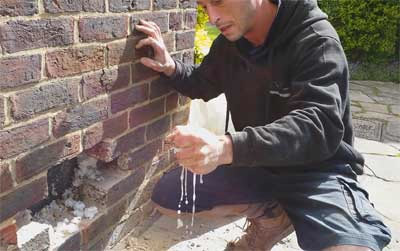
Photograph: Coastal Wall Ties
Who regulates the Cavity Wall Insulation industry?
I have received dozens of letters and e-mails from readers who say that, following installation of blown mineral-wool fibre, their inside walls have become damp and mouldy, and their homes have become uninhabitable and unsellable. And in every case the installers and their “guarantee” provider CIGA (the Cavity Insulation Guarantee Agency) has refused to acknowledge that the cavity wall insulation was the cause of their problems. In every case the installers and CIGA have insisted that the dampness problems were due to construction faults in the building (even though these are supposed to be identified by the “surveyor” prior to installation) or to “lifestyle condensation” caused by the occupants (even though condensation had not been a problem prior to the CWI).
However there have been some recent cases where homeowners have taken their cases to litegation and won the argument. Recently the issue has also been discussed in parliament.
Can cavity wall insulation allow rainwater across the cavity?
Despite the constant insistence by manufacturers and installers that cavity wall insulation cannot allow rainwater to cross the cavity, the Building Research Establishment has found that it can. Their findings have been published in a number of BRE publications, notably BRE Good Building Guide 44: part 2: “Insulating masonry cavity walls – principal risks and guidance” (available from www.brebookshop.com). This states, “There can be an increased risk of rain penetration if a cavity is fully filled with insulation, ie moisture is able to transfer from the outer to the inner leaves resulting in areas of dampness on internal finishes. Rainwater, under certain driving rain conditions, can penetrate the outer leaf of masonry leading to wetting of the cavity insulation, a reduced thermal performance and damage to internal finishes.”
The guidance document contains a table indicating the maximum exposure zones recommended for cavity wall insulation, for different cavity widths and different types of insulation material. There are many variables in this table, and I do not have room to explain them all here. But for the typical British house with face brickwork and 50mm cavities, the maximum recommended exposure is Zone 1 or Zone 2. As might be expected, Zone 1 is in the east of the country, and Zones 2, 3 and 4 are those progressively further west, with Zone 4 including the west of Scotland, west Wales, Cornwall and parts of Somerset and Dorset. The map describing these exposure zones (the British Standard wind-driven rain index) is reproduced in several BRE publications, including “Good Building Guide 44: Part 2”, “Thermal Insulation: avoiding risks”, and also in British Standard BS8104, and in Building Regulations Approved Document C (which can be downloaded free from www.planningportal.gov.uk).
The map gives a broad outline of those areas most likely to be affected by wind- driven rain (which is pretty much common sense anyway). But local conditions are also important; an exposed west-facing wall on high ground in London will possibly receive more rain than a sheltered wall in Cornwall (eg a house on an estate, close to other houses, which take the brunt of the prevailing weather). Many of the complaints I have received about dampness caused by cavity wall insulation have been from Exposure Zones 3 and 4, but I have also had complaints from London, Suffolk, Norfolk, Cambridgeshire and Lincolnshire – all firmly in Exposure Zone 1.
What percentage of properties with cavity wall insulation experience dampness problems?
There are no statistics about this, because no research has been done. The manufacturers, installers, CIGA and HM Govt (through their quango the Energy Saving Trust) all refuse to acknowledge that cavity wall insulation can cause dampness problems. I suspect that the problem is fairly widespread, however, and under-reported, for several reasons:
- I am the only writer for a national newspaper who has written about this problem, and every time I mention it, I receive dozens of e-mails and letters from readers complaining that their homes have become damp following cavity wall insulation. In most cases they have not previously reported the problem to anyone else. Where they have previously complained to the installers or the funding authority (either their local authority, energy provider, Help the Aged or the Government’s Warm Front scheme) they have been given the line that the cavity insulation cannot possibly have caused their dampness problems.
- Many readers complain that, following cavity wall insulation, they have suddenly started to experience “increased condensation”. They often put this down to a decrease in the “breathability” of their walls (or to the blocking-up of airbricks by the CWI installers – a surprisingly common occurrence), and compensate by opening windows to dry their homes out. They do not realise that the source of the extra water running down their windows and dripping from their ceilings is rainwater penetrating via the cavity wall insulation, and so have not bothered to report it to anyone.
- People who have not noticed visible dampness problems in their homes have nevertheless sometimes not experienced the expected savings in their fuel costs following CWI. In some cases, their fuel bills have actually got higher following cavity wall insulation. Others have reported that, whilst not experiencing obvious dampness problems, their homes seem to have become noticeably colder following CWI. This is because blown mineral-wool fibre has to become only slightly damp (around one per cent by volume) to lose all of its insulation properties. Any damper than this, and it will actually start to draw heat out of the house, as damp insulation is worse than no insulation at all, in the same way that a damp vest will make you colder than wearing no vest.
- Infra-red imaging company IRT Surveys Ltd has surveyed 250,000 properties across the UK and found that one-third of homes are well insulated, one-third have no insulation at all, and one-third have damp, slumping or missing insulation. The third with no insulation at all will include all the solid-walled Georgian, Victorian and Edwardian houses. The other two-thirds will be predominantly cavity-walled properties, and these statistics indicate that HALF of these are likely to have faulty insulation. CIGA itself has issued six million guarantees, so if IRT’s findings hold true, this would indicate that some three million UK homes have current or potential CWI problems.
Problems with gaps in the insulation, or only some walls being insulated
It should be added that even where it does not transmit rainwater across the cavity, CWI can still create dampness problems through increased condensation. Research has shown that 40 percent of houses whose cavity walls have been filled with blown mineral fibre suffer from gaps in the insulation, and it is these voids which cause condensation and black mould on the walls inside. Because, in a house which has been only partially insulated, the temperature still rises, and with it, the humidity – the amount of water vapour held in the air. And any remaining cold spots will therefore experience more condensation than before. Common areas for condensation and black mould growth are near ground level, between windows, and at ceiling level in upstairs bedrooms. There is a thermal image of a house with blown-fibre CWI – showing the effects of unfilled areas – on page 155 of my book, “The Sunday Telegraph Guide to Looking After Your Property”, available via the “books” page of this website.
The insulation installers are supposed to do a thorough survey of the cavity, and proceed only if the wall meets strict British Standards. In practice, hardly any cavity walls meet these standards, as they all have unfilled mortar joints, debris dropped down the cavity, and wall-ties covered with mortar droppings. But the installers press on regardless, and these imperfections and obstructions catch the insulation and stop it from filling the cavity evenly.
Another problem is insulation sinking to the bottom of the cavity, leaving cold areas at the top of the house or below windows, ripe for mould growth. Insiders say this is often due to insufficient fibre being used – a common problem with contractors employed on bulk contracts claiming the government subsidy, but who are insulating up to five houses per day at a price of only £100 each, when a good professional job should take a whole day, and cost at least £500. (If you have had blown fibre cavity insulation, and you suspect that it has settled, leaving gaps, then you can check for this by drilling holes near the top of the bedroom walls and inserting a fishing weight on a piece of string.)
Even when a cavity has been properly filled with mineral-wool fibre, however, the material will still break down and collapse over time. The fibres themselves become brittle and the material simply compacts under its own weight. How long does this take? – nobody knows, because the problem has never been independently researched. I suspect it happens much more quickly than most people realise – perhaps within five to ten years.
Are other materials better than blown mineral-wool fibre?
There are two other materials commonly used for cavity wall insulation – bonded polystyrene beads, and foam. If properly installed, these materials should theoretically be superior to mineral-wool fibre, as they are inherently waterproof. Neither material is used as widely as mineral-wool fibre because of cost. It can take two or three days to inject a house with either of these materials, and the cost is likely to be several hundred pounds, so they are not favoured by the government-funded schemes (which budget on around £100 per house for mineral-wool fibre). Neither material is without its problems, however.
Bonded polystyrene bead insulation has been reported to transmit rainwater across cavities. Although the individual polystyrene beads themselves are waterproof, if the cavity filling is incomplete, it can leave voids which are able to fill with water, and depending on the configuration of the voids, these can channel water across the cavity, instead of dripping straight down as advertised.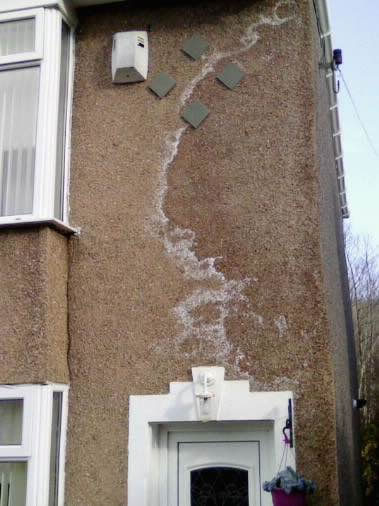
Dampness caused by Poly bead cavity insulation” (Photo Elaine Salveta)
The main readers’ complaint with bonded polystyrene beads, however, is that the bonding can be insufficient, allowing the beads to “escape”. Some readers have reported that when carrying out building alterations involving cutting into insulated walls, the beads have sometimes poured out of the wall. Others have reported beads escaping through airbricks, or blowing out of the top of the cavities into loft spaces, or even out through soffit vents into the gutters. There was an acknowledged problem with one particular brand of bonded polystyrene bead insulation widely used in the 1980s, which was put down to poor site supervision of the process – the adhesive has to be mixed with the poly beads immediately before they are injected into the wall – and this is said to have now been rectified. But any process that relies on on-site mixing will obviously always be prone to human error. Also, as with all modern plastics and adhesives, the technology has only been around for a relatively short time, and it is not known how well the material will age.
Ant infestation in Poly bead cavity insulation. (Photo Coastal Wall Ties).
It has to be mixed on-site prior to injection, and also has an uncertain longevity. All foam materials become brittle and shrink with age. This is the the reason why old fridges and freezers become less efficient, for example, as they are lined with foam insulation which gradually disintegrates.
Builders and DIYers have reported cutting into cavity walls filled with foam and finding nothing more than a layer of brown dust at the bottom.
I have also received two readers’ complaints of cracking damage – mainly to internal wall surfaces – following foam cavity wall insulation which, if proven, might possibly be due to the expansive force of the foam as it cures. If any readers have had similar experiences please contact me with details.
Some years ago there were concerns that urea formaldehyde foam cavity wall insulation might accelerate corrosion in galvanised steel wall ties, following several reported incidents of wall tie failure. Investigation by the Building Research Establishment failed to find definitive evidence that this was the case, although one particular type of wall tie (thin galvanised “butterfly” ties with a green coating) were advised to be possibly at risk, pending further investigation.
But it is important to realise that any type of iron or steel cavity wall tie is likely to have its life shortened following any type of cavity wall insulation. This is because the insulation – by definition – keeps the warmth on the room side of the wall (the inner leaf), therefore making the cavity itself, and the outer leaf, cooler. So warm moist air from inside the house will find its way through the wall, and condense out on the cooler wall ties, both in the cavity and where they are embedded in the mortar of the outer leaf. Where the cavity insulation is itself wet, then clearly it will be holding moisture in close contact with the wall ties, and hence accelerate their corrosion.
Wall tie corrosion
Wall ties are vital for the structural integrity of a cavity wall, as they hold the inner and outer leaves of masonry together. Being made of iron or steel, they will inevitably rust eventually, but in dry conditions they should last for many years. When persistently damp, however, they can corrode much quicker, and replacing them is a costly and time-consuming process, involving cutting out dozens of individual bricks from the outer leaf. Replacing corroded wall ties becomes much more difficult in a building with cavity wall insulation, as the insulation itself has to be removed around each tie, and then replaced afterwards.
Anyone thinking of having cavity wall insulation installed should first have the condition of their home’s wall ties assessed using the method described in BRE Digest 401, which specifies that two bricks should be removed on each elevation (at high and low levels) and tested for corrosion. Inspecting ties by drilling a hole in the outer leaf and looking through a boroscope is not a satisfactory way of assessing their condition, as the most serious corrosion is likely to be where the ties are embedded in the mortar. Wall tie corrosion is a growing problem, and mortgage valuation surveyors are increasingly recommending that wall ties should be inspected as a condition of a mortgage advance. It is likely that the widespread presence of retro-fill CWI will increase surveyors’ alertness to the possibility of wall tie corrosion, and might therefore create delays when homes with cavity wall insulation are put on the market. Homes most at risk of wall tie corrosion are those built with wrought-iron “fish-tail” ties prior to 1920, and those built with galvanised steel “butterfly” ties between 1964 and 1981. Any house about to have its cavity walls insulated is supposed to be inspected and assessed for suitability by “a trained surveyor” (ie a salesman for the insulation installers), but I have never come across a case where the wall ties have been assessed using the correct method. In most cases the “surveyor” simply drills a hole in the outer leaf and measures the width of the cavity.
I have also recently come across a case where a mortgage valuation surveyor has recommended refusal of a mortgage application on a house with retro-fit cavity wall insulation – the reason given being enhanced probability of wall-tie corrosion.
Conclusion
There are many people who have had cavity wall insulation installed, who have experienced no problems with internal dampness or wall tie corrosion, and have experienced increased levels of comfort and lower fuel bills. Unfortunately there are also people who have suffered serious problems, and who have found it very difficult – or impossible – to get these problems recognised and rectified. The cavity insulation industry, and government agencies, do themselves no favours by pretending that these problems do not exist. My own opinion is that injecting insulation into an existing cavity wall is a bad idea, with the potential to create problems whose rectification costs will far outweigh any savings in fuel costs, or corresponding environmental benefits. The best way to add thermal insulation to the walls of an existing home is on the outside or the inside, where the installation can be carried out under controlled site conditions, and any subsequent defects easily spotted and rectified. Installing insulation in an existing cavity wall by drilling holes in the outer leaf and squirting something in – in the hope that everything will be alright, even though you can’t see it – creates possibilities for problems.
So the choice is yours. I cannot advise any individual reader as to whether to have CWI or not. All I can do is provide some information about the potential drawbacks of cavity wall insulation which the installers, manufacturers, and HM Government would apparently prefer you not to have.
If you have been affected by cavity wall insulation problems – you can read about related problems on the cavity insulation help website.
[Post last updated 01/06/2015]

